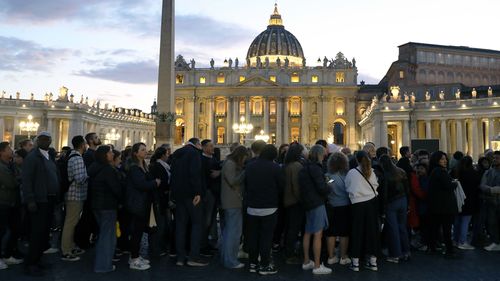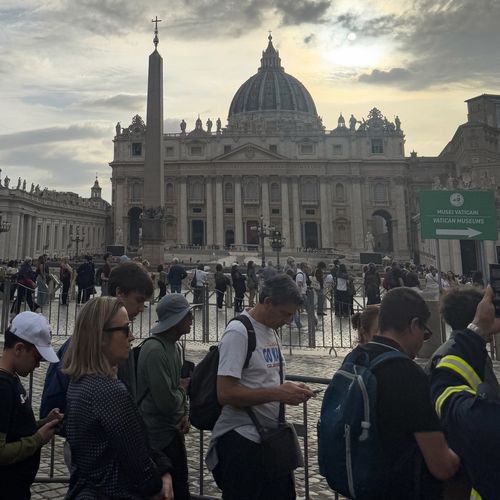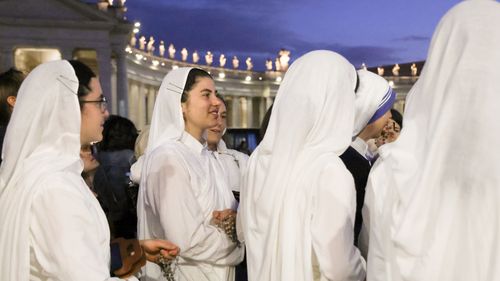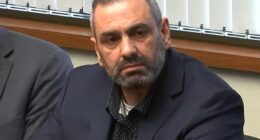Conversations in multiple languages hum in the background as the stoic crowd stands united in a shared moment of history, grappling not only with the loss of a deeply cherished spiritual leader, but also with the gravity of witnessing a moment that will echo through time.

“It’s a once-in-a-lifetime experience,” Linda Coorey, who’s travelling with fellow Australian Bernadette Lahood, says.
The pair, currently on holiday from Sydney, adjusted their itinerary to visit the Vatican in recognition of the impact Pope Francis had on their community.
“I think he was a particularly great pope, and certainly for our families, this is really important to pay our respects,” Lahood adds.
“They wish they could also be here, but they’re really glad that we’re here and able to experience this and share that experience with them back home.”

Crowds gather for procession of Pope’s body
Crowds are enduring waits of up to six hours for a glimpse of Pope Francis’s body, now lying in state beneath the majestic dome of St Peter’s Basilica.
The basilica’s great bell, Campanone, tolls solemnly, honouring the late pontiff in accordance with centuries-old tradition.
The sacred site remains open to the public day and night until the funeral tonight (AEST), allowing mourners from around the world to pay their final respects.
“It’s worth it,” Coorey says without hesitation.
To her, Pope Francis represented a leader who embraced everyone, regardless of their background.
“He was a people person – he loved being among ordinary people, not just dignitaries and politicians.”

Similarly for Lahood, the Pope’s inclusive nature set him apart, bridging a gap between generations.
“For young Catholics in their formative years he’s been a really good influence and been connected to all people, not just traditionalists, he’s had a lot of appeal to the broader community, both Catholic and non-Catholic and I think he’s been really vocal about issues that really represent how Christians should behave.”
Inside the Basilica, I’m told it’s an atmosphere of deep reverence and beauty as crowds silently shuffle past the open casket, rosaries in hand, to honour the man who led the Catholic Church for over a decade.
“Waiting outside was anxious and exhausting, but once I got in, it was beautiful,” New Yorker Nancy Jiang says.
“I was just in St Peter’s on Easter Saturday.
“Now going back in the evening and seeing everything lighten up, it was beautiful.
“Definitely worth the wait and lifetime experience.”

Among the many gathered in Rome today are South American Catholics, devoted followers of the late pontiff.
“The church is not just a European church, it’s a world church,” Brazilian Aducci Correia Kenig shares.
He’s confident the same sense of diversity will continue with the next leader, who will be decided by an inner sanctum of cardinals in the coming weeks.
“It was very important for the church… Because we had this South American pope from another continent so people from China, Australia and other places, they think ‘why not?”

True to his wishes for simplicity, Pope Francis will be buried in the Basilica of St Mary Major – a quieter, more humble resting place than some of his predecessors chose.
As the Vatican mourns, Catholics like Correia Kenig are hopeful that it’s not the end, but an exciting new beginning for the church.
“The faith is reborn… believers are coming back to the church, new believers, I hope this new pope will make the faith stronger so those far away from the church can return.”
While a new pope is expected to be elected by mid-May, the focus for now remains on remembering a leader who touched lives across continents with a message of mercy, dignity, and hope.





